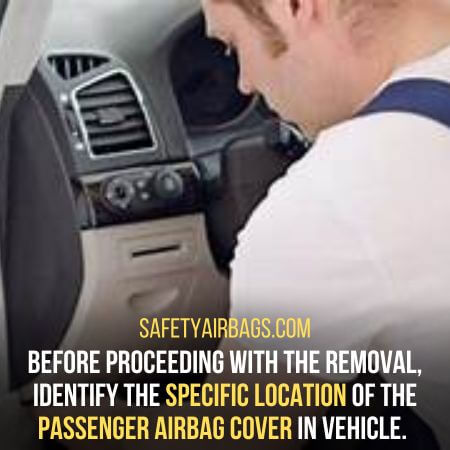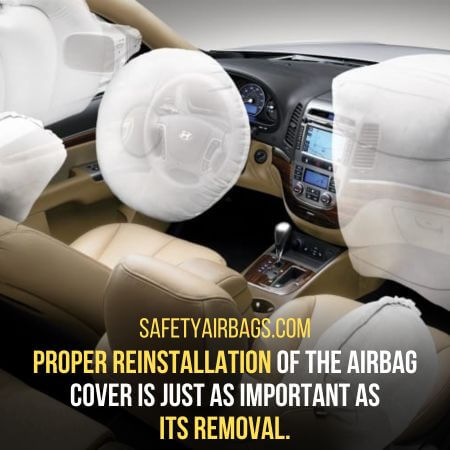How to remove the passenger airbag cover? Removing the passenger airbag cover is essential for various reasons.
What Will I learn
The airbag covers need removal for accessing and replacing faulty components, performing maintenance, or customizing the interior.
How To The Remove Passenger Airbag Cover – 5 Steps
Removing the passenger airbag cover involves locating and accessing the cover, disengaging securing clips or screws, carefully detaching the cover, and disconnecting electrical connectors.
Step 1: Locate and access the airbag cover:
Airbag covers are in different vehicle parts, such as the dashboard, steering wheel, or side panels.
Before proceeding with the removal, identify the specific location of the passenger airbag cover in your vehicle.

This will help you focus on the correct area and avoid accidentally tampering with other components.
To begin the removal process, you must also access your vehicle’s airbag cover. Identify whether the airbag cover is on the dashboard, steering wheel, or side panel.
This information will help you understand the specific steps in accessing the cover.
Step 2: Disengage any securing clips or screws:
Once you have accessed the airbag cover, you’ll likely find securing clips or screws that hold it in place.
Identify the fastening mechanisms used to secure the airbag cover. Common types include plastic clips, metal screws, or a combination of both.
Carefully examine the cover to locate these clips or screws. Use appropriate tools, such as a screwdriver or a trim panel removal tool, to remove them without causing damage.
Step 3: Carefully detach the airbag cover:
After disengaging the securing clips or screws, it’s time to detach the airbag cover from its housing or mounting area.
Gently pry the cover away from the housing, starting from one corner and gradually working your way around.
Apply even pressure and avoid excessive force to prevent damage to the cover or surrounding components. Take your time and be patient during this step.
Step 4: Disconnect the electrical connectors:
Before fully removing the airbag cover, disconnect the electrical connectors attached to the module.
These connectors provide power to the airbag system. Locate the connectors at the back of the cover or within the housing.
Carefully release the connectors using the appropriate method, such as pressing tabs or sliding locks.
Ensure that you disconnect all the necessary connectors to detach the airbag cover fully.
Step 5: Remove the airbag cover from the vehicle:
With the securing clips or screws disengaged and the electrical connectors disconnected, you can now remove the airbag cover from the vehicle.
Exercise extra caution during this step to prevent any accidental airbag deployment. Hold the airbag cover securely and lift it away from the mounting area.
Place the removed airbag cover safely without any potential damage or interference.
Preparing for the Removal Process
Preparing for the passenger airbag cover removal is crucial to ensure a smooth and safe procedure.
Here are the steps involved in preparing for the removal process:
1. Gather the necessary tools and materials:
Before starting the removal process, gathering all the required tools and materials is crucial. These may vary depending on your vehicle model.

But common tools often include a trim panel removal tool, a screwdriver set, a socket wrench, and a flashlight.
2. Understand the specific requirements for your vehicle:
Each vehicle model may have specific requirements and variations in the airbag cover removal process.
It is important to familiarize yourself with these requirements by referring to the vehicle’s technical manual or contacting the manufacturer.
Understanding your vehicle model’s specific steps and precautions will ensure a smoother and safer removal process.
3. Review the vehicle’s owner’s manual for guidance:
The vehicle’s owner’s manual is a valuable resource for understanding the components and procedures related to the airbag cover.
It provides detailed instructions and illustrations for your vehicle, guiding you through the removal process.
Take the time to carefully review the relevant sections to gain a comprehensive understanding of the steps involved.
Challenges In Removing The Airbag Cover
Removing the passenger airbag cover can be challenging due to various hurdles.
1. Firstly, the cover is securely attached to the dashboard, requiring the removal of surrounding panels and trim pieces, which can be time–consuming and intricate.
2. Additionally, accessing the airbag module often requires removing the glove compartment or other components, adding complexity to the process.
3. Another hurdle is the presence of hidden fasteners or clips that are not easily visible, requiring careful inspection and potentially specialized tools for removal.
4. handling the airbag system requires utmost caution to avoid accidental deployment, which poses a risk of injury.
5. Finally, reassembling the components after cover removal demands precision and knowledge of the correct sequence, further complicating the task.
Safety Precautions For Airbag Cover Removal
Safety precautions to remove airbags include disconnecting the vehicle’s battery and allowing sufficient time for the airbag system to power down.
It also includes using personal protective equipment (PPE) such as gloves and safety glasses.
1. Disconnect the vehicle’s battery:
Safety should always be a top priority when working with airbag systems.
Begin by disconnecting the vehicle’s battery to prevent accidental deployment.

Locate the battery in your vehicle and use the appropriate tools to disconnect the negative terminal first, followed by the positive terminal.
Take note of any specific instructions provided by the manufacturer regarding battery disconnection.
2. Wait for sufficient time to allow the airbag system to power down:
After disconnecting the battery, allowing the airbag system to power down completely is important.
This waiting period allows any residual power to dissipate, reducing the risk of accidental deployment.
Refer to the vehicle’s owner’s manual for the recommended duration to wait before proceeding with the removal process.
3. Use personal protective equipment (PPE) such as gloves and safety glasses:
When working with airbag components, it is essential to prioritize personal safety.
Wear appropriate personal protective equipment (PPE), such as gloves and safety glasses, to protect yourself from potential injury or debris.
PPE will help minimize the risk of cuts, scratches, or exposure to harmful substances.
4. Handle the airbag cover with care to avoid accidental deployment:
The airbag cover is a sensitive component; mishandling it can cause accidental deployment.
Always handle the airbag cover with extreme care, avoiding excessive force or impact.
Following proper techniques, such as using gentle pressure and supporting the cover from all sides, is crucial to prevent unintended activation.
Testing the Airbag System
Testing the airbag system involves reconnecting the vehicle’s battery, checking for error codes or warning lights, and conducting a test or simulation to ensure proper functionality.
1. Reconnect the vehicle’s battery:
After successfully removing and reinstalling the passenger airbag cover, it’s time to reconnect the vehicle’s battery.
Start by reconnecting the positive terminal followed by the negative terminal. Ensure a secure connection and tighten the terminals properly.
Take care to connect the battery in the correct order to prevent any electrical issues.
2. Turn on the ignition and check for any error codes or warning lights:
Once the battery is reconnected, turn on the ignition without starting the engine.
Observe the instrument panel for error codes or warning lights related to the airbag system.
These warning lights may include the airbag light or a specific airbag-related indicator.
If warning lights illuminate, consult the vehicle’s owner’s manual or seek professional assistance to diagnose and resolve the issue.
3. Conduct a test by simulating an airbag deployment (if applicable) to ensure proper functionality:
Some vehicles may have a built-in feature that allows you to simulate an airbag deployment for testing purposes.
Refer to the owner’s manual to determine if your vehicle offers this functionality. If available, follow the specific instructions to conduct the airbag deployment simulation.

This test helps ensure that the airbag system is functioning correctly and ready to deploy in the event of an accident.
During the simulation, be prepared for loud noises, such as a discharge sound, as the airbag inflates.
Maintaining a safe distance from the airbag module during this test is crucial.
4. Monitor the airbag system for some time to ensure no issues arise:
After conducting the airbag deployment simulation, or if such a simulation is not applicable, it is important to monitor the system for some time.
Pay attention to any unusual noises, odors, or warning lights that may indicate a potential issue with the airbag system.
If you notice any abnormalities, consult a qualified professional to diagnose and address the problem promptly.
It is recommended to periodically check the airbag system for functionality, especially after any maintenance or repairs involving the airbag components.
Regular inspections help ensure that the airbag system remains in optimal condition, providing the necessary protection in an accident.
Conclusion:
In conclusion, safely removing the passenger airbag cover is of utmost importance for various reasons, including accessing and replacing faulty components, performing maintenance, or customizing the interior.
By following the specific instructions for your vehicle model and taking necessary safety precautions, you can ensure a successful and secure removal process.
Understanding that each vehicle model may have unique requirements and variations in the airbag cover removal process is crucial.
Therefore, it is essential to refer to your vehicle’s owner’s manual or consult the manufacturer for accurate instructions.
Following the specific guidelines ensures that you approach the removal process correctly and minimize the risk of damaging the airbag system or other components.
Proper reinstallation of the airbag cover is just as important as its removal.
Ensuring the cover is correctly aligned and securely fastened, and all electrical connectors are properly connected is vital for maintaining the integrity of the airbag system.
Testing the airbag system after reinstallation is crucial to ensure its proper functionality.
